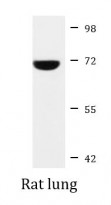ARG40954
anti-FOXK2 / ILF antibody
anti-FOXK2 / ILF antibody for Western blot and Human,Mouse,Rat
Overview
| Product Description | Rabbit Polyclonal antibody recognizes FOXK2 / ILF |
|---|---|
| Tested Reactivity | Hu, Ms, Rat |
| Tested Application | WB |
| Host | Rabbit |
| Clonality | Polyclonal |
| Isotype | IgG |
| Target Name | FOXK2 / ILF |
| Antigen Species | Human |
| Immunogen | Recombinant fusion protein corresponding to aa. 511-660 of Human FOXK2 (NP_004505.2). |
| Conjugation | Un-conjugated |
| Alternate Names | ILF; ILF1; ILF-1; nGTBP; Forkhead box protein K2; Cellular transcription factor ILF-1 |
Application Instructions
| Application Suggestion |
|
||||
|---|---|---|---|---|---|
| Application Note | * The dilutions indicate recommended starting dilutions and the optimal dilutions or concentrations should be determined by the scientist. | ||||
| Positive Control | Rat lung | ||||
| Observed Size | 69 kDa |
Properties
| Form | Liquid |
|---|---|
| Purification | Affinity purified. |
| Buffer | PBS (pH 7.3), 0.02% Sodium azide and 50% Glycerol. |
| Preservative | 0.02% Sodium azide |
| Stabilizer | 50% Glycerol |
| Storage Instruction | For continuous use, store undiluted antibody at 2-8°C for up to a week. For long-term storage, aliquot and store at -20°C. Storage in frost free freezers is not recommended. Avoid repeated freeze/thaw cycles. Suggest spin the vial prior to opening. The antibody solution should be gently mixed before use. |
| Note | For laboratory research only, not for drug, diagnostic or other use. |
Bioinformation
| Database Links | |
|---|---|
| Gene Symbol | FOXK2 |
| Gene Full Name | forkhead box K2 |
| Background | The protein encoded by this gene contains a fork head DNA binding domain. This protein can bind to the purine-rich motifs of the HIV long terminal repeat (LTR), and to the similar purine-rich motif in the interleukin 2 (IL2) promoter. It may be involved in the regulation of viral and cellular promoter elements. [provided by RefSeq, Jul 2008] |
| Function | Transcriptional regulator involved in different processes such as glucose metabolism, aerobic glycolysis and autophagy (By similarity). Recognizes and binds the forkhead DNA sequence motif (5'-GTAAACA-3') and can both act as a transcription activator or repressor, depending on the context (PubMed:22083952, PubMed:25451922). Together with FOXK1, acts as a key regulator of metabolic reprogramming towards aerobic glycolysis, a process in which glucose is converted to lactate in the presence of oxygen (By similarity). Acts by promoting expression of enzymes for glycolysis (such as hexokinase-2 (HK2), phosphofructokinase, pyruvate kinase (PKLR) and lactate dehydrogenase), while suppressing further oxidation of pyruvate in the mitochondria by up-regulating pyruvate dehydrogenase kinases PDK1 and PDK4 (By similarity). Probably plays a role in gluconeogenesis during overnight fasting, when lactate from white adipose tissue and muscle is the main substrate (By similarity). Together with FOXK1, acts as a negative regulator of autophagy in skeletal muscle: in response to starvation, enters the nucleus, binds the promoters of autophagy genes and represses their expression, preventing proteolysis of skeletal muscle proteins (By similarity). In addition to the 5'-GTAAACA-3' DNA motif, also binds the 5'-TGANTCA-3' palindromic DNA motif, and co-associates with JUN/AP-1 to activate transcription (PubMed:22083952). Also able to bind to a minimal DNA heteroduplex containing a G/T-mismatch with 5'-TRT[G/T]NB-3' sequence (PubMed:20097901). Binds to NFAT-like motifs (purine-rich) in the IL2 promoter (PubMed:1339390). Positively regulates WNT/beta-catenin signaling by translocating DVL proteins into the nucleus (PubMed:25805136). Also binds to HIV-1 long terminal repeat. May be involved in both positive and negative regulation of important viral and cellular promoter elements (PubMed:1909027). [UniProt] |
| Cellular Localization | Nucleus. [UniProt] |
| Calculated MW | 69 kDa |
Images (1) Click the Picture to Zoom In






